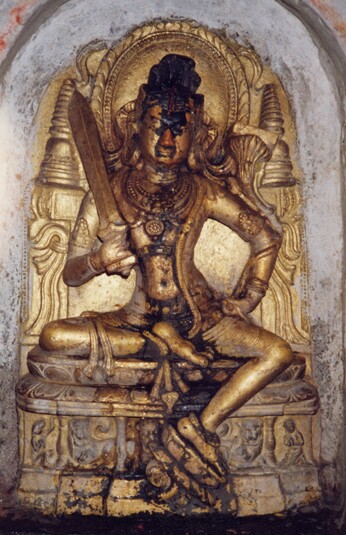
Item: Manjushri (Bodhisattva & Buddhist Deity)
| Origin Location | Northern India |
|---|---|
| Date Range | 1100 - 1199 |
| Lineages | Buddhist |
| Material | Stone, Painted Face/Hair |
| Collection | Private |
Classification: Deity
Manjushri-ghosha, Kumara (English: Youthful Prince, Melodious Voice): when this photo was taken in December 1980 the sculpture resided in a temple in the Laughing Charnel Ground across from the entrance to the Bodhgaya Temple, Bihar, India. It is said that sometime after that date this sculpture was replaced or moved.
An outline drawing of the sculpture was first made by Francis Buchanan-Hamilton in the winter of 1811-1812. This image was later reproduced in the Martin publication of 1838 (see image below).
This form of Manjushri is non-iconic, or aniconic. It is not described in Tantric texts, meditations or rituals. It is based on the Sutra literature. The pose with the right hand grasping the sword at the chest is seen in a few other sculptures of Manjushri, primarily Western Himalayan standing figures. The left hand turned with the back of the hand resting on the thigh is reminiscent of a royal pose. The left leg pendant is unusual as it typically signifies a more wrathful or fierce manner. Over-all this sculpture is a master work of Pala creativity. The artist has captured the image of Manjushri as a prince with both beauty and strength.
Jeff Watt 1-2009 [updated 6-2018, 8-2018]
(Background information on early publication was provided by Claudine Bautz-Picron).
Martin, Montgomery. 1838. The History, Antiquities, Topography, and Statistics of Eastern India; comprising the districts of Behar, Shahabad, Bhagulpoor, Goruckpoor, Dinajepoor, Puraniya, Rungpoor, & Assam in relation to their Geology, Mineralogy, Botany, Agriculture, Commerce, Manufactures, Fine Arts, Population, Religion, Education, Statistics, Etc. ..., vol. I. Behar (Patna City) and Shahabad, London: WM H. Allen and Co. Leadenhall-street.
Buddhist Deity: Manjushri Main Page
Buddhist Deity: Manjushri, Arapachana (Leg Pendant)
Buddhist Figure: Bodhisattva Sculptural Forms (Non-iconic)
Art History: Medium, Sculpture - Stone
Buddhist Deity: Manjushri (Non-iconic Forms)
Buddhist Deity: Manjushri Iconography
Buddhist Deity: Manjushri (Bari Gyatsa, edited)
Buddhist Deity: Manjushri (Sword Upraised)
Buddhist Deity: Manjushri, Arapachana (Various Forms)
Buddhist Deity: Manjushri Sculpture Page
Buddhist Deity: Manjushri (Sculpture Masterworks)
Buddhist Deity: Manjushri (Leg Pendant)
Buddhist Deity: Manjushri (Relaxed Left Arm or Sattva Posture)
Sculpture: Famous Works
Sculpture: Figurative, Three Parts
Buddhist Deity: Manjushri, Rare & Unusual Forms
Sculpture: Stone (Masterworks)
Subject: Tiger Claw Necklace
Buddhist Deity: Manjushri (Indian Sculpture)
Buddhist Deity: Manjushri, 3 Iconographic Topics (Arapachana)




